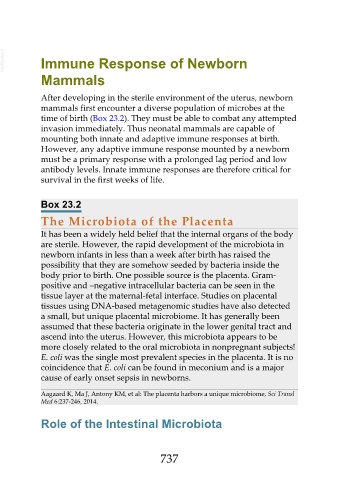Page 737 - Veterinary Immunology, 10th Edition
P. 737
VetBooks.ir Immune Response of Newborn
Mammals
After developing in the sterile environment of the uterus, newborn
mammals first encounter a diverse population of microbes at the
time of birth (Box 23.2). They must be able to combat any attempted
invasion immediately. Thus neonatal mammals are capable of
mounting both innate and adaptive immune responses at birth.
However, any adaptive immune response mounted by a newborn
must be a primary response with a prolonged lag period and low
antibody levels. Innate immune responses are therefore critical for
survival in the first weeks of life.
Box 23.2
The Microbiota of the Placenta
It has been a widely held belief that the internal organs of the body
are sterile. However, the rapid development of the microbiota in
newborn infants in less than a week after birth has raised the
possibility that they are somehow seeded by bacteria inside the
body prior to birth. One possible source is the placenta. Gram-
positive and –negative intracellular bacteria can be seen in the
tissue layer at the maternal-fetal interface. Studies on placental
tissues using DNA-based metagenomic studies have also detected
a small, but unique placental microbiome. It has generally been
assumed that these bacteria originate in the lower genital tract and
ascend into the uterus. However, this microbiota appears to be
more closely related to the oral microbiota in nonpregnant subjects!
E. coli was the single most prevalent species in the placenta. It is no
coincidence that E. coli can be found in meconium and is a major
cause of early onset sepsis in newborns.
Aagaard K, Ma J, Antony KM, et al: The placenta harbors a unique microbiome, Sci Transl
Med 6:237-246, 2014.
Role of the Intestinal Microbiota
737

